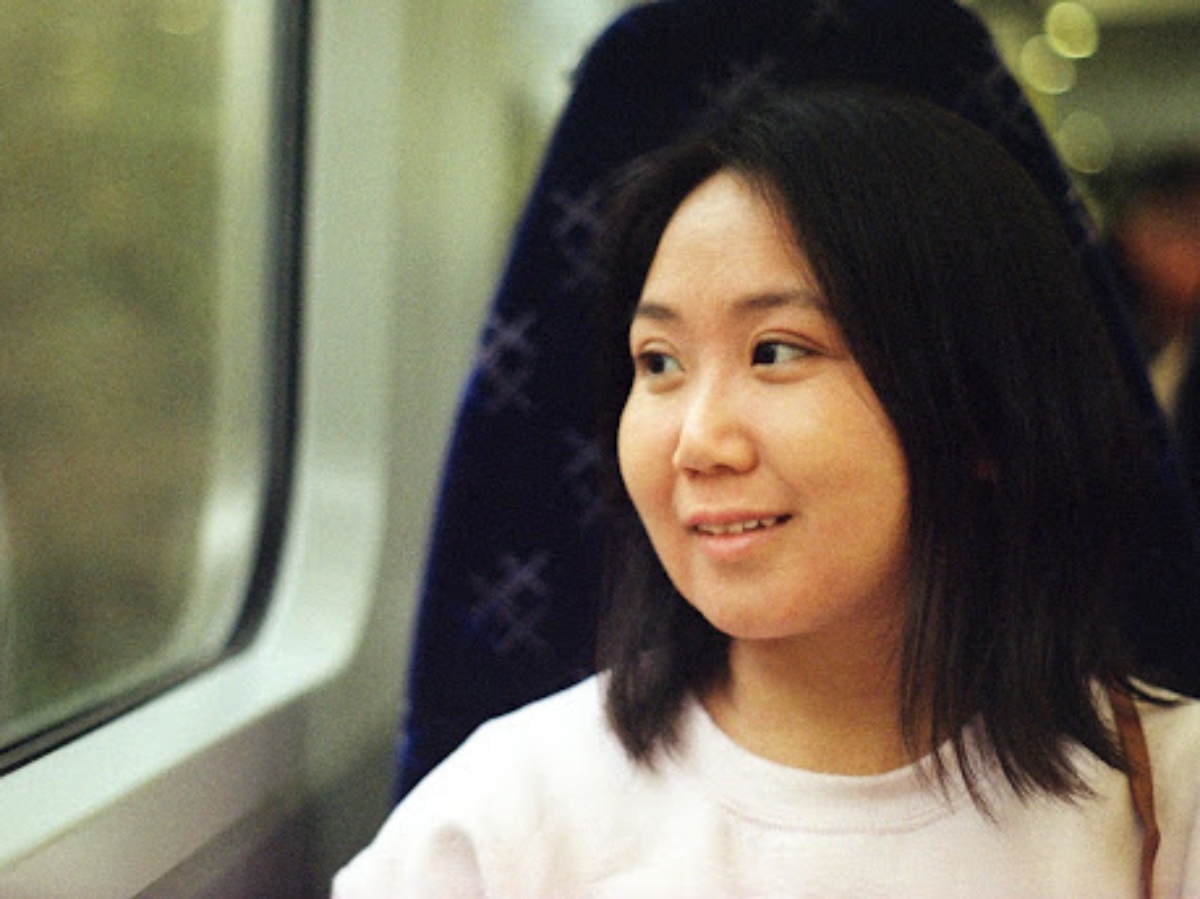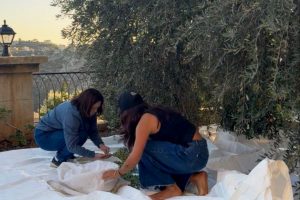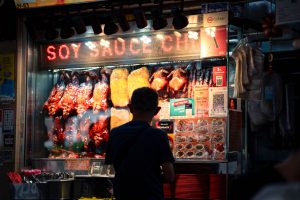All images courtesy of Yeo Jing Rui.
In ‘Singaporeans Abroad’, we share the stories of locals who—thanks to living in a globalised world—have found success in different corners of the globe, whether financially, romantically, or for the pure joy of adventure.
We’ve recently heard from Xian Jie, a documentary production assistant turned tour guide in Japan, in the midst of restoring a 120-year-old traditional Japanese house. Then, there was Chef Nora Haron, who’s flourishing in the buzzing food scene of sunny California with her take on nusantara cuisine.
Now, we bring you Jing Rui, whose decades of battling severe eczema and topical steroid withdrawal led her to set up her own skincare clinic in the UK.
I’ve dealt with severe eczema my whole life. Think raw, itchy wounds all over my body that would sting under something as innocuous as air conditioning in the MRT.
Due to my experiences with this condition in Singapore, I moved to the UK in May 2021 to start Skin Solace Aesthetic Clinic, a skincare clinic that helps others facing the same predicament. At that point, I had left my full-time job as a social worker due to the toll it was taking on my skin, and I wasn’t sure about going back to it.
Even though I was also helping people then, something still felt missing. Being a voice and building a community for other eczema sufferers like me felt like a calling.
Growing Up With Eczema
My skin issues first started when I was a baby. Funnily enough, my dad was pursuing his masters in the UK back then—the country I’d eventually settle in decades later.
Born in 1993, I remember growing up as a quiet, cautious kid. In kindergarten, little things like the sandals I wore would give me wounds on my feet, so I had to be careful when it came to playing or taking part in physical activities.
It was during my time in Raffles Girls’ Primary School that I grew quite self-conscious of my skin. I’d wear longer pinafores and really high socks to cover the wounds on my calves. Other kids would make fun of my wounds and even call me names!
My parents were always applying creams—including topical steroids—on me every day, and bandaging my wounds before I went to bed. But when I was 12, I decided to take things into my own hands.
I reduced the amount of creams that I applied on myself because I personally didn’t like how it felt or how it smelt. Sometimes, it would even sting my open wounds.
I’d see some short-term improvements while using the prescribed creams, but flare-ups returned whenever I stopped applying them. Intuitively, I felt like I knew that this was not the solution for me and I didn’t want to rely on the creams forever.
When I reduced my cream application when I was 12, I went through a mild case of Topical Steroid Withdrawal (TSW).
TSW is a condition that can develop when you stop applying topical steroids after using them for a prolonged period of time, as many eczema sufferers do. Not everyone with eczema who uses steroid creams ends up with TSW, and the symptoms are different for everyone. But I experienced painful flare-ups from top to toe.
Without really knowing why, I enjoyed a short bout of good skin between the ages of 14 and 16. Then, at 16, O-Level exam stress kicked in and my skin issues surfaced again.
My condition continued to worsen throughout my time at Anglo-Chinese School (Independent), where I took the International Baccalaureate (IB) track. It peaked when I was 18, and I had to be hospitalised for two weeks.
The doctors put me on a strong course of topical and oral steroids and applied wet wraps. Wet wrapping is a technique that allows the skin to absorb topical creams more effectively. This is achieved by applying a layer of topical steroids and a layer of moisturisers, then wearing a pair of wet pajamas followed by a set of dry pajamas.
I was filled with dread when I was put under the protocol—I had been through this many times as a child, and I knew that it would cause more damage.
I had the sinking feeling that my skin would ‘explode’ the moment I got discharged and discontinued the medication.
And it did. My skin went into a massive flare-up, and that’s when my TSW journey truly started.
The Worst TSW of My Life
To say it affected my day-to-day life is an understatement.
Going to school or work was really difficult. I had many raw, painful open wounds that felt like burns all over my body. I couldn’t move without being in pain. Just getting out of bed was so hard. I would unconsciously scratch my skin raw overnight, and the wounds would hurt when I woke up. I would be soaked in blood and ooze. I was sleeping until 2 PM or 3 PM each day because I just could not get up.
There would be skin flakes everywhere across the sheets and on the floor. I had to change my sheets every single day to maintain basic hygiene.
Wearing clothes was another struggle. They would stick to my skin, and I would have to change my clothes a few times a day due to the pus, wiping my skin down each time.
Simple activities of daily living, such as getting up to go to the bathroom proved to be difficult due to the sores on my legs.
Somehow, I managed to complete my (IB) exam. I missed school for a long time, so I studied as much as possible at home. Thankfully, I did well enough to enter the National University of Singapore, where I studied social work.
Naturally, I embarked on a social work career after graduation. But my skin condition also affected my professional life. During my commutes and my time in the office, the air conditioning blowing dry air on my wounds was a source of constant bother.
There was also the issue of my job being front-facing—I had to interact with clients—but I looked like I needed help more than they did!
Thankfully, I had really understanding colleagues who made as many concessions as possible, allowing me to work from home part of the time. But it soon became clear that it was not sustainable. After a year, the discomfort forced me to leave.
Socially, I ended up isolating myself because I wouldn’t feel like going out. I didn’t feel like eating with friends, couldn’t put on makeup, and couldn’t wear nice clothes. I’d have to go to places with just the right environment to feel comfortable. I would be fatigued from spending a mere two hours out because my body was expanding large amounts of energy to heal my wounds.
Inevitably, my relationship with my parents got strained due to my condition. To be honest, I was not myself—I was cranky and in a bad mood most of the time due to being in chronic pain. I had many arguments with them and talked back to them frequently.
At the same time, guilt and shame would take over, and I would try my best not to let them worry. There were times I’d secretly cry in my room.
Healing My Skin on My Own Terms
After swearing off steroids, I tried alternative treatments like Traditional Chinese Medicine (TCM), which did help to alleviate the symptoms. But what changed the trajectory of my skin healing journey was a chance encounter.
After leaving my social worker job, I worked part-time to do videography for events. At a medical event, a participant approached me after noticing I had TSW. He turned out to be Peerawat Jay, a therapist who, at that time, had been treating TSW for over 15 years in Thailand.
I started undergoing a weekly treatment called cold atmospheric plasma (CAP) at his skincare clinic in Singapore and saw massive changes to my skin.
The non-invasive treatment is supposed to help the skin regenerate and heal. My oozing wounds slowly dried up and scabbed over, and I also saw improvements in my ‘elephant skin’— a type of skin condition that some TSW sufferers get from prolonged moisturiser use, repeated scratching or topical steroid use.
Today, I mainly suffer from dry skin. Even though my skin isn’t perfect, I’ve come a long way and am happy with where I am. TSW is a journey, not a destination!
As my skin continues to improve, I’ve also learned to love it more. I still have some hyperpigmentation and hypopigmentation—remnants from my healed wounds. People usually ask me, “Do you think those scars will go away?”
And I’m just like: “It’s fine.”
After what I’ve been through, a little discolouration is nothing. I am happy to have healthy, functioning skin again. In fact, I like my pigmentation because it tells my story. With self-acceptance and self-love, you start to appreciate things about your skin, your body, how they work, and what they can do for you.
Turning Pain Into Passion
Ten years ago, when I was going through the thick of it, TSW wasn’t a thing. TSW was not recognised, and it still is not now. Medical professionals didn’t acknowledge or understand my aversion to steroids.
I was alone in the struggle for a long time. Connecting with others with the same condition through social media helped me feel more normal. The sense of community was positive for my mental health. Forgive the cliche, but we were all in it together. When I saw us getting better, I began to feel that there was some meaning to the struggle. It wasn’t all for nothing.
That was a big part of the inspiration behind my TSW advocacy on Instagram and on my website.
There was a need to raise awareness about this issue and to stop the overuse of steroids. I didn’t want others to fall into the same ‘trap’.
The transition from becoming an advocate to making it my career happened when I connected with a fellow TSW sufferer Louise King.
Louise, who’s from the UK, had come to Singapore to treat her skin. I found out from her that there weren’t many treatment options in the UK, and they didn’t have CAP there.
She suggested partnering up to start our own clinic in the UK. By then, I had left social work for some time, but I still enjoyed helping others. As part of my TSW advocacy, I was able to answer people’s questions and see them get better, and it felt good. Experiencing life away from Singapore was another draw.
Preparations began in 2020, from securing a start-up visa to rustling up the funds for the business. My skin had already cost my parents a crazy amount growing up. Each TCM visit was at least $100, and a sachet of medicine was about $4 each.
So when it came to launching a business, I dipped into my savings instead. Fortunately, Louise and I had family investors who also helped with the start-up cost.
Bossing Up Despite Flare-Ups
Now, most of my days are spent at our clinic, Skin Solace, where I manage patients and their conditions. I guess you could say that I am putting my social work skills to good use!
Louise, on the other hand, takes care of the operational and administrative side of things, like making sure we’re following all the requisite business regulations.
We’re based in Winchester, a town in the county of Hampshire, and treat 40 clients a week for their TSW, acne, as well as bacteria and fungal infections. The clinic is doing well—we’re operating at full capacity and have plans to get more therapists on board. Expanding to other parts of the UK and Europe is on the cards as well.
For the two years we’ve been running, we’ve managed to help a high percentage of cases.
The most memorable ones are the severe cases that have been going through skin struggles for years but manage to get better. Their hair grows back, and their skin becomes stronger. Some have gotten better and managed to get married with beautiful skin, while those with children can now enjoy their time with their kids without being in pain.
But it wasn’t always smooth sailing.
Before we moved the clinic to Winchester, we were located in Andover, a small town in the English countryside. It was where Louise lived, and we had decided on setting up there first due to the uncertainty of COVID and the lockdowns.
When business started picking up in October 2021, I was on the brink of burnout. I was a new business owner, learning how to manage a growing business. I was also entering my first British winter. I started experiencing significant difficulties with my mental health and developed anxiety.
You see, once it hit 4 PM, it would turn pitch black in the English countryside—there were no lights on the street I lived on. I can’t even see my hand if I stretch it out in front of me.
In sunny Singapore—where it is constantly warm, and houses are installed with large, open windows—you feel like you are outside even if you have been in all day. In the UK, windows are small to keep the heat in, and it can feel claustrophobic when you’ve been inside all day.
With everything going on, my skin had a massive flare-up throughout my first winter there. I had to stop work, and Louise had to cover for me for a month so that I could recover and recuperate.
Despite everything, I’ve learned a lot about my limits and am picking up skills every day to fulfil my new role, such as learning how to manage staff. I am also adapting to the culture—speaking proper English instead of Singlish, for instance!
Chuffed To Be in the UK
I do enjoy how ‘polite’ people are here.
In Singapore, I get more comments and unsolicited advice about my skin. Many people come up to me on the street while I’m doing my own thing. Without finding out more, they would dish out advice. “By the way, have you tried coconut oil?”
Some Singaporeans can be pushy and try to sell me multi-level marketing products. This can make someone with skin conditions self-conscious—it does nothing to build up their confidence.
Here, people are generally quite respectful and do not bring up my skin unless I mention it first.
I am happy and comfortable here, so returning to Singapore isn’t in my plans yet. The cooler UK weather is better for my skin than a humid, tropical climate. Plus, I found a partner here.
We met on a dating app a few months after I moved here, and we’ve been living together for half a year. No looking back for me; I’m building my life over here.
The Glow Up
Fortunately, the distance hasn’t hindered my relationship with my parents. It might even have been good for us.
We keep in touch pretty regularly on WhatsApp, and they recently came to visit in October for two weeks.
It was quite a milestone as it was their first time seeing the clinic in person. Thankfully, they were quite impressed. I think, in a way, up till that moment, they’d still thought of me as a kid.
My mum, especially, was very emotional. I felt like she was thinking: “Oh, my baby has truly left the nest. She’s got her own space now.”
In hindsight, I honestly can’t imagine my life any other way even though it took a lot of suffering to get here.
I used to wonder what the point of living was. But as my skin has healed, I’ve realised that there’s meaning in the struggle. Now, I’m resilient, I love my skin, and I love that I can help other people feel the same way.






